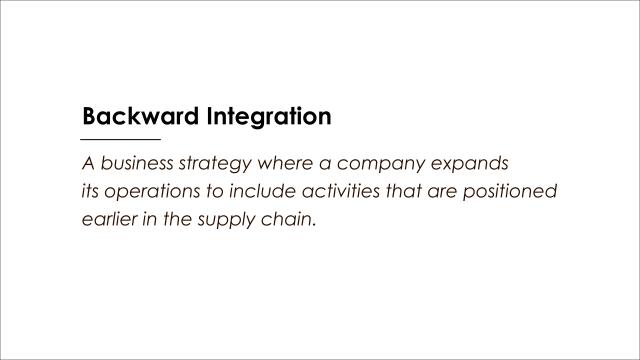| Image: Moneybestpal.com |
Main Findings
- Backward integration is a strategic business approach where companies expand their operations upstream in the supply chain by acquiring or controlling suppliers, raw material sources, or production facilities.
- By vertically integrating backward, companies can achieve several benefits, including cost reduction, and supply chain control.
- Overall, companies must carefully assess the costs, benefits, and risks associated with backward integration initiatives and ensure alignment with their strategic objectives and long-term growth plans.
Backward integration is a business strategy where a company expands its operations to include activities that are positioned earlier in the supply chain.
In other words, it involves integrating Backward into the production process by acquiring or establishing control over suppliers, raw material sources, or upstream activities.
Key Elements
Backward Integration allows companies to gain greater control over their supply chain, reduce dependency on external suppliers, and capture more value from the production process. This strategy can take various forms, including vertical integration through acquisitions, partnerships, joint ventures, or the establishment of new production facilities.
Related Articles
Examples
An example of Backward Integration is a clothing manufacturer acquiring a textile mill to produce its own fabrics instead of relying on external suppliers. By integrating backward into fabric production, the clothing manufacturer can secure a stable supply of high-quality materials, reduce costs, and enhance operational efficiency.
Why Backward Integration
Supply Chain Control
One of the primary reasons companies pursue backward integration is to gain greater control over their supply chain.
By bringing key production activities in-house, companies can reduce reliance on external suppliers and mitigate risks associated with supply chain disruptions, quality issues, or price fluctuations.
Cost Reduction
Backward integration can lead to cost savings by eliminating markups from intermediate suppliers and streamlining production processes.
By producing essential components or raw materials internally, companies can capture economies of scale, optimize resource utilization, and achieve greater efficiency in the production process.
Quality Assurance
Integrating backward allows companies to maintain consistent quality standards throughout the production process.
By controlling raw material sourcing and production activities, companies can ensure the quality, reliability, and conformity of inputs to meet their specific requirements and customer expectations.
Strategic Advantage
Backward integration can provide companies with a strategic advantage by enhancing their competitiveness, market positioning, and differentiation.
By controlling critical inputs or technologies, companies can differentiate their products or services, innovate more effectively, and respond swiftly to changing market demands.
Supply Chain Resilience
In today's volatile business environment, backward integration can enhance supply chain resilience and flexibility.
By diversifying sourcing options and reducing dependency on external suppliers, companies can better withstand disruptions, geopolitical risks, or market uncertainties that may impact the availability or cost of inputs.
Vertical Integration Benefits
Backward integration complements vertical integration strategies, where companies seek to control multiple stages of the value chain.
By integrating backward, companies can strengthen their vertical integration efforts, capture more value along the supply chain, and achieve synergies across different business units or divisions.
Formula
Backward integration does not have a specific mathematical formula like some financial metrics. Instead, it involves strategic decision-making and operational implementation.
However, certain financial metrics can be used to assess the financial impact of backward integration and evaluate its feasibility. These metrics include:
Return on Investment (ROI)
ROI measures the profitability of an investment relative to its cost. For backward integration projects, ROI can be calculated by dividing the net benefits or savings generated by the integration effort by the total investment cost.
The formula for ROI is:
Payback Period
The payback period represents the time it takes for the benefits of a backward integration project to equal its initial investment cost. A shorter payback period indicates a quicker return on investment and may be preferred by companies.
The formula for calculating the payback period is:
Payback Period = Annua

